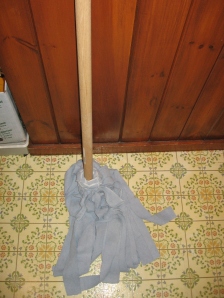So, today’s No Impact Week assignment was simple: Go forth and make no trash.
Simple, but not easy. Now I should say we do not, as a household, make much trash. We live in a rural area, and so any trash we make, we have to take to the dump ourselves. We see, and smell, what happens to that trash. We have to pay, by the pound, for every bag we dump. If everyone in America had to deal with their trash as directly as we do, I suspect we’d have very little trash problem.
Still, though, we generate plenty of garbage. Yesterday, to prepare, the manual asked us to keep all of our trash in a single receptacle, for sorting later. Here’s what went into it yesterday:
- A used tissue (first thing Sunday morning, I got up and blew my nose before I knew what had happened. Damn!)
- Two used maxipads and the wax paper backings and plastic packets associated with them
- Two sheets of clear vinyl that had come off the corners of a mirror we had purchased a long time ago. To the mirror’s credit, these two small corners were its only packaging — at least, the only packaging that made it to us. I pulled these sheets out and am keeping them to make something out of.
- Dental floss
- Used q-tips
- Used up tape from a child’s supposedly “no impact” art project
- Empty plastic/metal packages that contained the cat’s special kidney diet cat food
- A plastic ziploc bag the cat barfed on — We just decided to wash it in ultra hot water and keep it after all. Now none of you will ever accept a ziploc bag from me, right?
- An ice cream container would have gone into it, except I upcycled it into a seriously gorgeous royal purple gift box that I’d be genuinely proud to give anyone. Go me!
So today our objective was to add no more trash to this pile. It was hard, and we weren’t totally successful. In the morning, I flossed my teeth (my dentist insists). I can’t think of a good substitute — would buying dental picks and picking my teeth instead work as well, do you think? Any dental hygienists in the crowd to advise me?
I skipped the q-tips, which was a hard personal sacrifice, I tell you.
I folded up a rag in my pants for the maxi pad, and this worked just fine. Another wonderful illustration of marketing-invented need. I didn’t bleed all over, and I suppose the only innovation I might make to make this into a permanent change would be to add some velcro strips to some undies and some rags to keep me from dumping the rag in the can. But that’s a nicety, not a necessity. I’m left wondering why I ever used those disposable diapers for women, anyway!
In the morning, anticipating my usual sources of trash at work, I brought along a dry erase board eraser (I don’t have one, and am ashamed to admit that hitherto I was using Kleenex culled from virgin forests in insane quantities to wipe my whiteboard) and several rags to work. A rag to be a maxi pad, a rag to be a napkin for my lunch, and a rag for a hankie. Then I got to work and promptly sneezed, grabbing a Kleenex instead of my rag! Phooey!
I made a lot of paper recycling, and I brought home my apple core for our compost pile, but otherwise I didn’t make any more trash at work.
At school, Floppy used his t-shirt for his napkin at lunch (and was thrilled to do so, I might add). Otherwise, he said, he forgot all about it and threw away two paper towels and a milk carton with abandon. He recycled his paper.
Here working at home, Jeremy threw away a tissue (he also forgot!) and a cat food container. He had to buy catfood today, and we’ve decided the cat also gets the food-buying exception to nonconsumption. He asked at the vet if the food came in any more environmentally friendly containers. The answer is no. However, some vets here carry other brands of prescription kidney disease cat food that come in cans, so we may try to switch.
At the end of the day, I pulled a string off of the rag that was destined for my pants, and then went, hell! What do I do with this? But we decided to put it with the garden things, for tying up next summer’s tomatoes.
So that was our trash for today. We reduced somewhat, but we certainly didn’t eliminate. And we were struck by how angry we were at our trash, and also how automatic it has become to generate the stuff — so automatic we don’t use alternatives even if they are literally in hand.

















